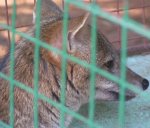 The Argentine gray fox (Pseudalopex griseus) goes by a couple of other names, namely Chilla or the Grey Zorro. Argentine gray fox can be located in the south part of South America, especially Chile or Argentina. At Argentina, the Argentine gray fox lives at the semi-arid parts. Most specifically, they live in the sandy soil, shrubs and grasslands too. Numbers-wise, they hold the largest in Chile, the smallest numbers are in Peru. They could also be seen on both ends of Andes Mountain range.
The Argentine gray fox (Pseudalopex griseus) goes by a couple of other names, namely Chilla or the Grey Zorro. Argentine gray fox can be located in the south part of South America, especially Chile or Argentina. At Argentina, the Argentine gray fox lives at the semi-arid parts. Most specifically, they live in the sandy soil, shrubs and grasslands too. Numbers-wise, they hold the largest in Chile, the smallest numbers are in Peru. They could also be seen on both ends of Andes Mountain range.Argentine gray foxes are small, weighing at around 2.5 to 4 kilograms, and lengthwise, they could go from 43 centimeters up to 70 centimeters. Diet of these foxes is made up of: rabbits, birds and rodents. Technically though, these foxes fall under the omnivores.
Breeding occurs in March, and when a gestation of two months has passed, 2-4 newborns would form the litter. In the way of caring for the newborns, both genders participate.
The Argentine gray fox holds long canines, its tail is very obvious, ventrally, dark brown while it is black at the other areas. The snout of the Argentine gray fox is sharp, and its ears are triangle-shaped.
They are social creatures and live in burrows or even dens found in rocks. It is not a safe place for these foxes, and I mean "absolutely safe", they are hunted.
Interesting fact: You may find it weird, but this particular fox is capable of eating geese.
Picture of the Argentine gray fox © 2006 Carla Antonini , licensed under Creative Commons Attribution-ShareAlike 2.5 Argentina
Keywords: gray
The Argentine gray fox, chilla, grey zorro, south american grey fox is listed as Least Concern. Does not qualify for a more at risk category. Widespread and abundant taxa are included in this category, on the IUCN Red List of Threatened Species
Namings for the Argentine gray fox
A young / baby of a Argentine gray fox is called a 'cub, kit or pup'. The females are called 'vixen' and males 'reynard, todd or dog'. A Argentine gray fox group is called a 'leash or skulk'.Argentine gray fox habitats
Artificial / Terrestrial, Forest, Grassland, Mediterranean-type Shrubby Vegetation, Pastureland, Shrubland, Temperate forest, Temperate Grassland and Temperate Shrubland
Custom Search